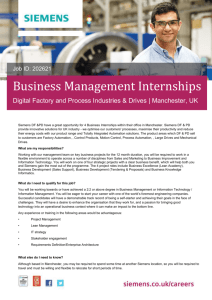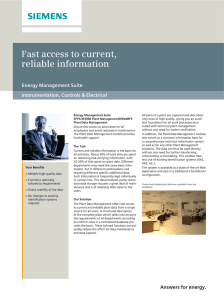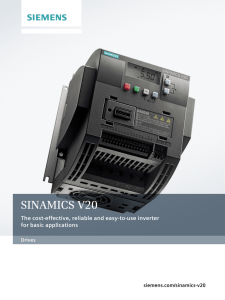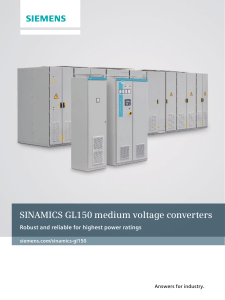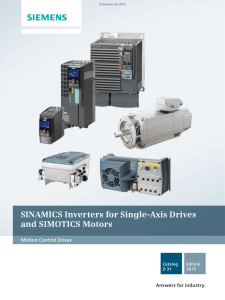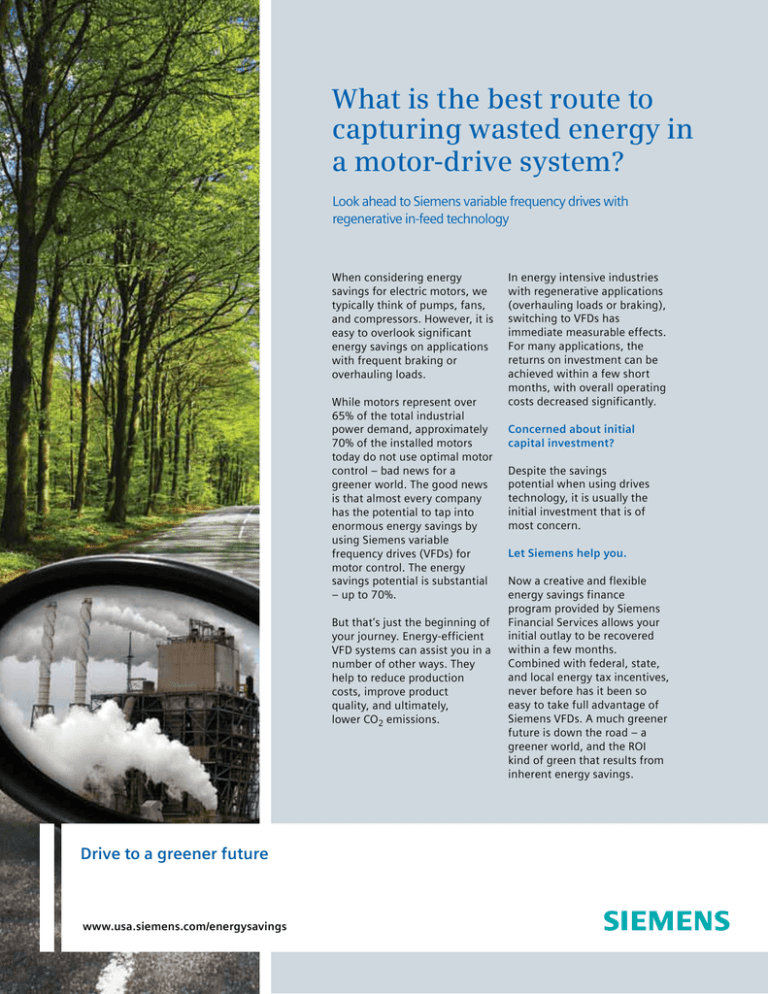
What is the best route to
capturing wasted energy in
a motor-drive system?
Look ahead to Siemens variable frequency drives with
regenerative in-feed technology
When considering energy
savings for electric motors, we
typically think of pumps, fans,
and compressors. However, it is
easy to overlook significant
energy savings on applications
with frequent braking or
overhauling loads.
While motors represent over
65% of the total industrial
power demand, approximately
70% of the installed motors
today do not use optimal motor
control – bad news for a
greener world. The good news
is that almost every company
has the potential to tap into
enormous energy savings by
using Siemens variable
frequency drives (VFDs) for
motor control. The energy
savings potential is substantial
– up to 70%.
But that’s just the beginning of
your journey. Energy-efficient
VFD systems can assist you in a
number of other ways. They
help to reduce production
costs, improve product
quality, and ultimately,
lower CO2 emissions.
Drive to a greener future
www.usa.siemens.com/energysavings
In energy intensive industries
with regenerative applications
(overhauling loads or braking),
switching to VFDs has
immediate measurable effects.
For many applications, the
returns on investment can be
achieved within a few short
months, with overall operating
costs decreased significantly.
Concerned about initial
capital investment?
Despite the savings
potential when using drives
technology, it is usually the
initial investment that is of
most concern.
Let Siemens help you.
Now a creative and flexible
energy savings finance
program provided by Siemens
Financial Services allows your
initial outlay to be recovered
within a few months.
Combined with federal, state,
and local energy tax incentives,
never before has it been so
easy to take full advantage of
Siemens VFDs. A much greener
future is down the road – a
greener world, and the ROI
kind of green that results from
inherent energy savings.
Regeneration
When evaluating an efficiency upgrade in your facility, a common
mistake is to only optimize the performance of a specific piece of
equipment. It is important to factor in the benefits available from a
complete system perspective.
Regeneration is an integral part of a complete drive solution that will
make a considerable difference in the ROI on your complete energy
efficiency upgrade efforts.
By capturing the electrical energy normally wasted when stopping or
cycling a motor, regenerative in-feed technology allows the wasted
energy to be returned back to your facility power grid for use
elsewhere, thereby reducing the overall power demand, and
ultimately reducing your energy costs.
Buy new or upgrade?
There are savings potential to be realized in almost every industry.
The decision on whether to introduce a completely new concept or
upgrade your existing equipment must be made on a case-by-case
basis. With new systems, it is relatively easy to calculate how quickly
the additional costs for an energy-efficient drive system will be
recovered.
When considering an upgrade, it is important to look at the
application. The more energy-intensive the application or the longer
a motor operates at partial load, the faster an energy-efficient VFD
system will pay off.
Siemens SINAMICS VFDs for wasted energy recovery
Siemens SINAMICS family of drives features several solutions for
regenerative applications. In the low-voltage range, these include the
SINAMICS G120, S120, S120CM, and S150. Siemens drives are
equipped with an array of innovative functions for optimum motor
control. What’s more, our all-new Intelligent Operator Panel (IOP)
significantly simplifies operator control.
SINAMICS regenerative in-feed drives
Regenerative infeed drives return energy back into the supply
system instead of wasting the energy in the form of heat or inertial
load losses. Efficient In-feed Technology offered on the SINAMICS
G120 brings you the smallest regenerative drive for general purpose
applications.
Smart Infeed Technology provides a low cost regenerative drive for
larger ratings typically in large, high performance industrial
installations and for motion control.
Active Infeed Technology, as provided by the SINAMICS S120 series,
combines regenerative operation with power quality management,
improving overall systems efficiency. By virtually eliminating
Siemens Industry, Inc.
Drive Technologies
3333 Old Milton Parkway
Alpharetta, GA 30005
1-800-964-4114
info.us@siemens.com
www.usa.siemens.com/energysavings
harmonics and optionally providing power factor control to
compensate for poor power factor from other loads, Active Infeed
drives can provide stable operation of the load on very weak supply
systems with voltage fluctuations, and can also help to stabilize the
supply system.
Ask Siemens about the applications and benefits of SINAMICS
regenerative infeed technology
• Continuous braking with 100% of the rated power
• Conserves energy by regenerating (returning excess energy
generated from braking or high inertia loads) back into the power
system for use by other equipment
• Does not produce additional heat during braking
• Eliminates the cost and time required to design/engineer, mount
and wire additional components, such as braking resistors, braking
choppers, and cables
• Efficient compact design
• Reduces input power
• Regenerative technology for all needs, from low HP general
purpose applications to high performance industrial installations
and for motion control
• Some models feature power quality management, by virtually
eliminating harmonics and optionally providing power factor
control to compensate for poor power factor from other loads —
can help to stabilize the supply system, improving overall systems
efficiency
Contact your local Siemens representative today to put you on
the road to energy savings.
Subject to change without prior notice
Order No.: GDFL-00800-0710
All rights reserved
Printed in USA
©2010 Siemens Industry, Inc.
The information provided in this brochure contains merely
general descriptions or characteristics of performance
which in case of actual use do not always apply as described
or which may change as a result of further development
of the products. An obligation to provide the respective
characteristics shall only exist if expressly agreed in the
terms of contract.
All product designations may be trademarks or product
names of Siemens AG or supplier companies whose use by
third parties for their own purposes could violate the rights
of the owners.


